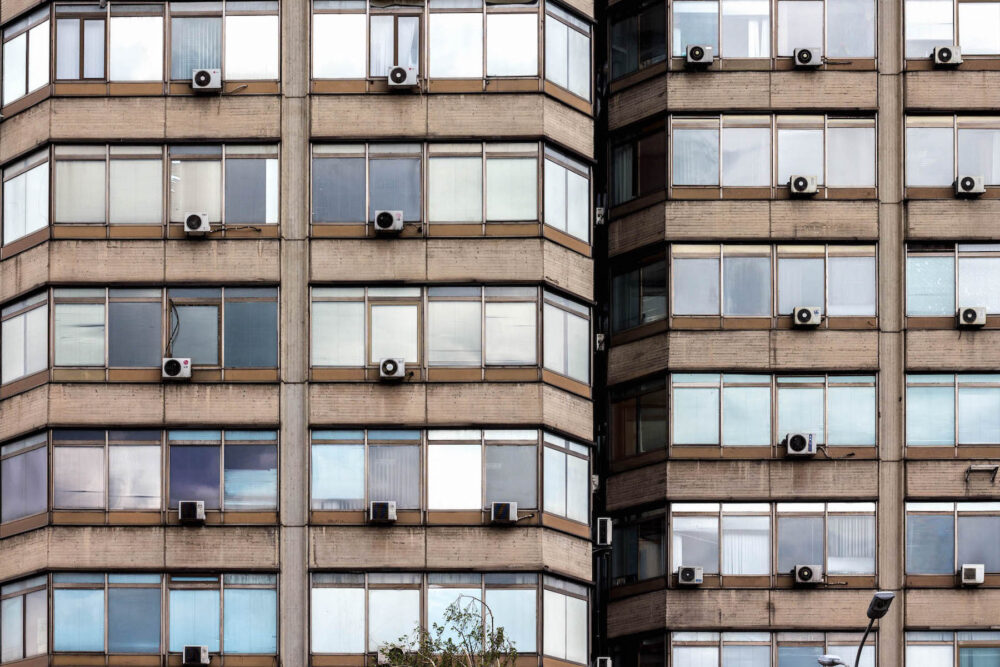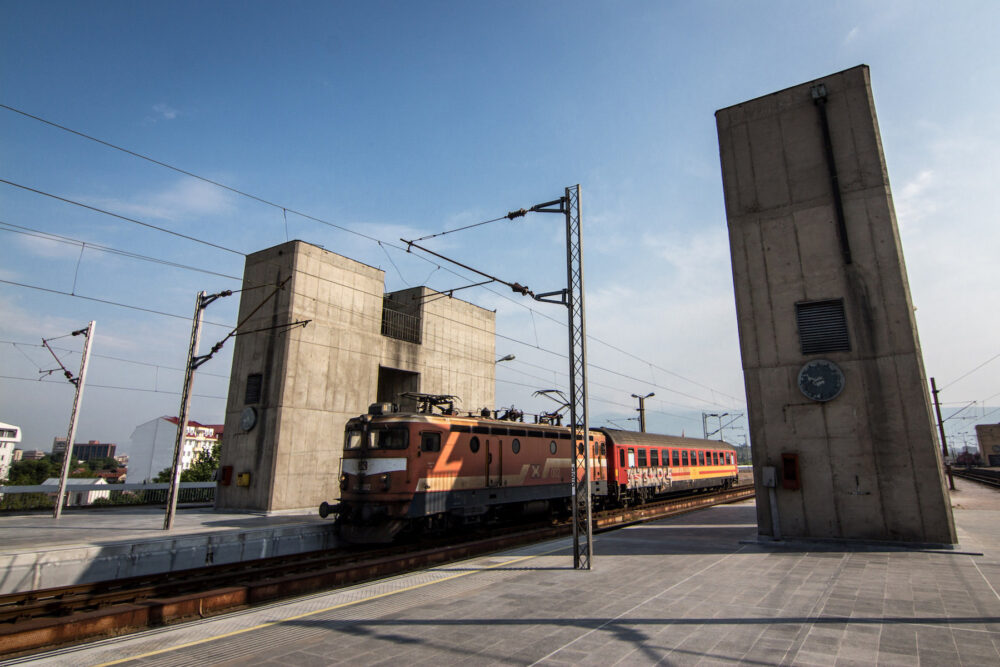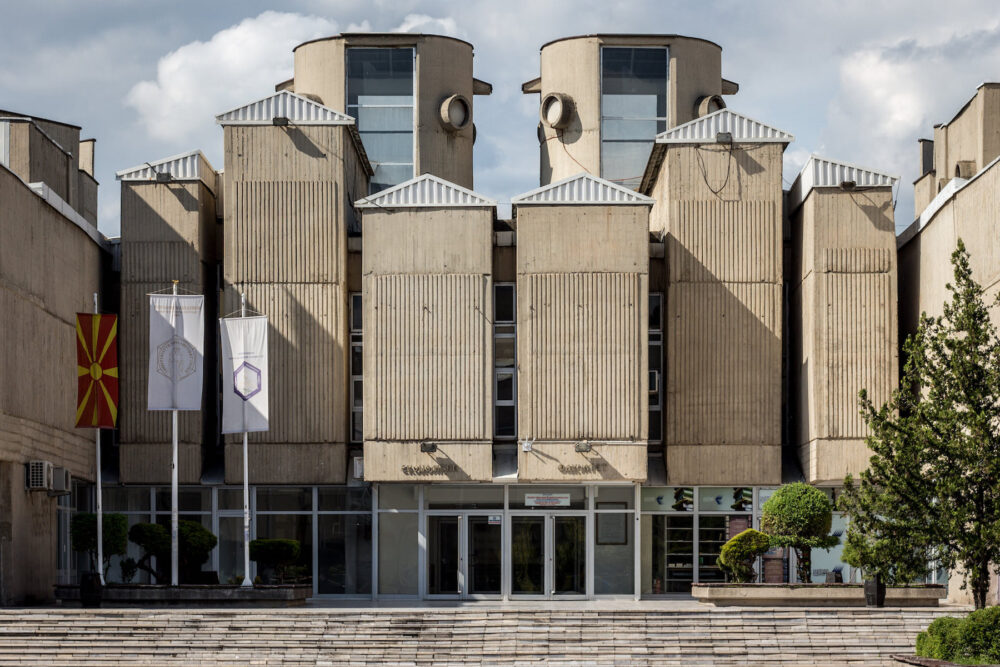Cities rarely have the opportunity to completely reinvent themselves. In the case of Skopje, the capital of North Macedonia, it has happened twice now in the past 60 years.

Skopje’s Post Office HQ building, North Macedonia (Photo: Darmon Richter)
Skopje’s first, Brutalist architectural makeover owes itself to a powerful earthquake on 26 July 1963, when around 80% of the city’s buildings were destroyed. A coordinated international response for the city’s reconstruction drew the attention of some of the world’s most prestigious architects; with the 1965 design competition being won by the Japanese architect Kenzō Tange. Tange created a “City Centre Master Plan” for rebuilding Skopje, and the results were radical – Yugoslavia received a conceptually original and relentlessly modern “city of the future,” featuring works by both notable Yugoslav architects and some of the leading visionaries of world architecture.
Half a century later, much of this work would be hidden by a second attempt at reinventing Skopje. The divisive “Skopje 2014” project was financed by the North Macedonian government, and sought to replace Skopje’s international Modernist architecture with what was perceived a more monumental and historical style. Sheer concrete walls were covered with plaster panels. Brutalist porticos were replaced by neo-classical pillars. Extravagant statues to historical figures began popping up in every conceivable space. Still, many of Skopje’s 1960s Brutalist masterpieces remain on display, and the following ten entries highlight some of the more notable examples.

The Macedonian Academy of Sciences and Arts (Photo: Darmon Richter)
Academy of Sciences and Arts
The Macedonian Academy of Sciences and Arts (MANU) was established post-earthquake, in 1967. Following a design competition, construction of the academy’s facility in Skopje began in 1974 under the native Macedonian architect Boris Čipan. His design incorporated bare concrete facades alongside elevated verandas and extended balconies that are reminiscent of vernacular folk architecture – a nod to the history and heritage of the region. Opened in 1976, the academy building is spacious and light inside, and features a number of notable artworks, including a mural by Gligor Čemerski, and stained glass windows by the artist Borko Lazeski.
Boulevard Krste Petkov Misirkov, Skopje 1000
City Trade Centre (GTC)
Skopje’s Gradski Trgovski Centar (GTC) – meaning “City Trade Centre” – was built in a central location close to the city’s Macedonia Square. The design competition was won by Živko Popovski, who between 1969 and 1973 oversaw the construction of a large multilevel complex, including interior shopping spaces, open-air market areas, and a series of stepped terraces facing out onto greenery. It remains the largest and busiest shopping centre in the city. More recently though, the GTC became a point of contention following the onset of the Skopje 2014 project – when the government decided to hide the building’s original exterior and aesthetics beneath a new layer of decorative pillars and domes in a neoclassical style, while also adding new statues onto the roof. In response, a protest movement was formed and gained support also from the Association of Macedonian Architects (AAM), and to date, the GTC maintains its original, if somewhat aged, appearance.
13 November Quay, Skopje 1000

Skopje’s Central Registry building (Photo: Darmon Richter)
Central Registry
The Central Registry building was included as part of Tange’s city plan, as a home for the National Bank of the Republic of Macedonia – a function that it still performs. It took the form of concrete and glass towers, with a minimalist design, the taller tower rising to a height of roughly 35 metres. These administrative blocks were then connected to a horizontally-arranged body for public-facing offices and archives. Designed by architects Radomir Lalović and Olga Papeš, and approved by Tange himself, the Central Registry was built between 1971 and 1975. A year after its opening, the building’s lobby would also receive a notable work of revolutionary art: a mural titled “Fresco for the National Liberation War,” measuring 8 by 3.7 metres, and created by the abstract painter Borko Lazeski.
Bulevar Kuzman Josifovski Pitu, Skopje, 1000

Hydrometeorological Service Building in Skopje, North Macedonia (Photo: Darmon Richter)
Hydrometeorological Service Building
North Macedonia is a small but geologically diverse country. It features mountains and lakes, with forests covering more than a third of the territory. The climate ranges from continental, to mountainous, to sub-Mediterranean, and is monitored closely via a series of meteorological stations established throughout the country. These fall under the guidance of the North Macedonian Hydrometeorological Service, which was established in 1947. The main building of the Hydrometeorological Service Institute is located on the northern edge of Skopje. Designed by architect Krsto Todorovski and built from 1972 to 1975, the building consists of a series of office blocks constructed in a Brutalist style, and rising in the centre into a triangular stack formed from suspended units positioned between three cylindrical pillars.
Skupi 18, Skopje 1000

Telecommunications Centre & Post Office HQ (Photo: Darmon Richter)
Telecommunications Centre & Post Office HQ (PTT Centre)
After the former post office was destroyed by the 1963 earthquake, the new City Centre Master Plan by Kenzō Tange proposed the creation of a replacement facility in the same location, close to the central Macedonian Square. A 1968 competition to select a design was won by Macedonian architect Janko Konstantinov, whose concept played with forms reminiscent of Metabolist architecture – consisting of large concrete cylinders, and organic-looking shapes; including the main post office hall topped by a rotunda resembling a flower. In 1972, Konstantinov and his team began construction of the complex, which ultimately took the form of three distinct units. The first to be built was a tower with horizontal units at its base, which would house the Skopje telephone exchange. Next, work began on the second unit: the “Counter Hall” of the main post office, pictured here. It was referred to this way for the public-facing post office counters housed inside, though this concrete rotunda also served as the overall headquarters for the post service. Originally filled with decorative frescos, and lavish white marble floors, Skopje’s Post Office HQ building has subsequently slipped into a state of disrepair, particularly following a fire in January 2013; leading the heritage conservation group Europa Nostra to nominate it to their “7 Most Endangered” programme in 2021. The EU Ambassador to North Macedonia, David Geer, commented: “The Central Post Office designed by Macedonian architect Janko Konstantinov is one of the finest buildings to have emerged from the rubble of the devastating 1963 earthquake … As we mark the 60th anniversary of the earthquake, it is time to take action to protect this masterpiece of modernism.”
Boulevard VMRO, Skopje 1000

Central Post Office designed by Macedonian architect Janko Konstantinov (Photo: Darmon Richter)
MEPSO Building
The third unit of the Telecommunications Centre would serve as an administrative building, positioned alongside Skopje’s central square. It was designed by Macedonian architect Zoran Štaklev, in accordance with the architectural vision for the complex by Janko Konstantinov, and construction lasted from 1987 until 1989. Here were located the offices for the national electricity board, which today gives the building its common name: the MEPSO (Electricity Transmission System Operator of North Macedonia) building. Originally designed in the Brutalist style, with a solid concrete roof suspended on regularly placed pillars between full-height glass panels, as part of the Skopje 2014 project the MEPSO building was completely remodelled, its original design being hidden under a new faux neo-classical facade.
Maksim Gorki 4, Skopje 1000

The MEPSO Building (Photo: Darmon Richter)
Nikola Karev High School
In parallel to his work on the Telecommunications Centre, Janko Konstantinov also oversaw the creation of a new school between 1968 and 1970. The Nikola Karev High School stood in the Karposh residential area, west of the city centre. This Brutalist school building was composed of a series of upright cylindrical and rectangular units, while alongside the main building were positioned a separate open-air amphitheatre and a sports hall. The Nikola Karev High School was designed to accommodate 1,400 students, and continues that function today.
Nikola Rusinski 2, Skopje 1000
Skopje Train Station
After the city’s former train station was destroyed in the 1963 earthquake, the newly reimagined and rebuilt transport hub that replaced it would form a key feature in Tange’s City Centre Master Plan. Relocated to sit directly on the existing train line between Serbia and Greece, construction of the new station began in 1971 under the guidance of Tange himself. It was an ambitious project, and would take a decade to complete: with ten platforms on a raised elevation above street level. The interior spaces beneath featured ticket desks and a restaurant, all decorated in Tange’s trademark minimal Brutalist style.
Bojmija 4, Skopje 1000

Skopje Train Station (Photo: Darmon Richter)
Saints Cyril and Methodius University (UKIM)
The original complex of the Saints Cyril and Methodius University was built in the 1940s. The post-earthquake rebuild gave an opportunity for the facility to expand, however, and to that end Tange’s Master Plan for the city moved Skopje University to a new location, where there was space for a more ambitious campus layout. The young Slovenian architect Marko Mušič and his team won the open design competition, with a four-year construction process beginning in 1970. Mušič’s design was oriented around a central square, where the concrete towers and facades of the university buildings take on playful and sometimes almost church-like shapes; facing in towards a Modernist statue of the Saints Cyril and Methodius, brothers from this region who in the 9th century were responsible for creating the first Slavic alphabet.
Boulevard Goce Delchev 9, Skopje 1000

Saints Cyril and Methodius University (Photo: Darmon Richter)
Goce Delchev Student Dormitory
The Goce Delchev Student Dormitory was designed by architect Georgi Konstantinovski, and took its name from the anti-Ottoman revolutionary of the same name, who was active at the turn of the 20th century and is celebrated as a national hero today both in North Macedonia and neighbouring Bulgaria. Konstantinovski’s dormitory building was completed in two phases, with the first side opening in 1971 and the second in 1977. The concept was for a complex that could provide affordable accommodation for as many as 1,200 students, and Konstantinovski achieved this with a Brutalist and almost monumental form: consisting ultimately of four 13-storey towers in rotating alignment around a central plaza, and joined together by elevated passages that created an aerial square above.
Londonska, Skopje 1000
For those wishing to know more about the architecture of Skopje, check out the building database at Architectuul, this Spomenik Database article, and the paper map of Brutalist architecture in Skopje published by Blue Crow Media.